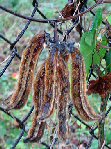Itching in Panama: Dealing with Pica Pica

Summer has come to Panama, vines are flowering and seed pods are emerging. One particular vine with purplish flowers and brown seed pods that you may find on the border of your property is Mucuna prurita, aka cowhage, cow-itch, horse-eye, nipay, oyo de venado, velvet bean, Hell Fire Bean, and (in Panama and much of Central America) pica pica. The fine hairs on the seed pods dislodge with touch or a faint breeze causing intense itching if they land on your skin. Consider judicious use of broadleaf herbicides such as Roundup™ and Scythe™ as well as gloves, long shirt, and long pants when working with pica pica.
Picar: Spanish verb meaning to itch. Pica: present tense of verb meaning itches or itching. Pica pica: lots of itching caused by the fine hairs on the seed pods of Mucuna prurita. The seeds of this plant are medicinal. Containing L-dopamine, they can be used to treat Parkinson’s Disease. The pods also contain other alkyloids such as dimethyltryptamine and have been used in folk medicine for alleged aphrodisiac properties. But, it is the velvety, chemical containing, hairs on the pods that get on the skin and cause the itch.
Pica Pica is Everywhere in the Tropics
This plant probably stated in Africa but has spread throughout the tropics. Here is a description of the vine from the “Principal Weeds Agronomist” in the Weeds Branch in Darwin, Australia.
Cow itch is a hairy annual or short lived perennial herb. It is a twining or scrambling leguminous vine with a trifoliate leaf not unlike the pasture plants calopo and puero. In both its native and introduced habitat it climbs up tree trunks and becomes entwined in the foliage. The leaflets are 7-13 cm long, 2-7 cm wide, and the petiole (leaf-stalk) is 10-30 cm long. Groups of dark purple flowers hang from the vine. The pods are curved, 4-8 cm long with longitudinal ribs, and are covered with dense, orange coloured hairs. Each pod usually contains five to six shiny, brown, oval seeds, 10 mm long and 7 mm wide. Reproduction is by seed.
Getting Rid of It
This vine is hard to get rid of. If you chop it up and let it lie on the ground it has the ability to re-root. However, it is susceptible to broad leaf herbicides. There are reports of the successful use of Round Up™ mixed with Scythe™. Cover up (hat, long sleeved shirt, long pants, gloves), chop the plant down, spray the herbicide mix on the chopped parts and also treat the stump. Repeat as needed. This plant is a very successful competitor. Ignoring it won’t work unless you plan to move away, soon.
Treatment
This is a temporary condition albeit very annoying. Immediate washing with lots of soap and water may help. Also washing clothing worn while working with the plant is essential as the hairs will stay on the clothing and cause irritation when you put the clothes on again.



